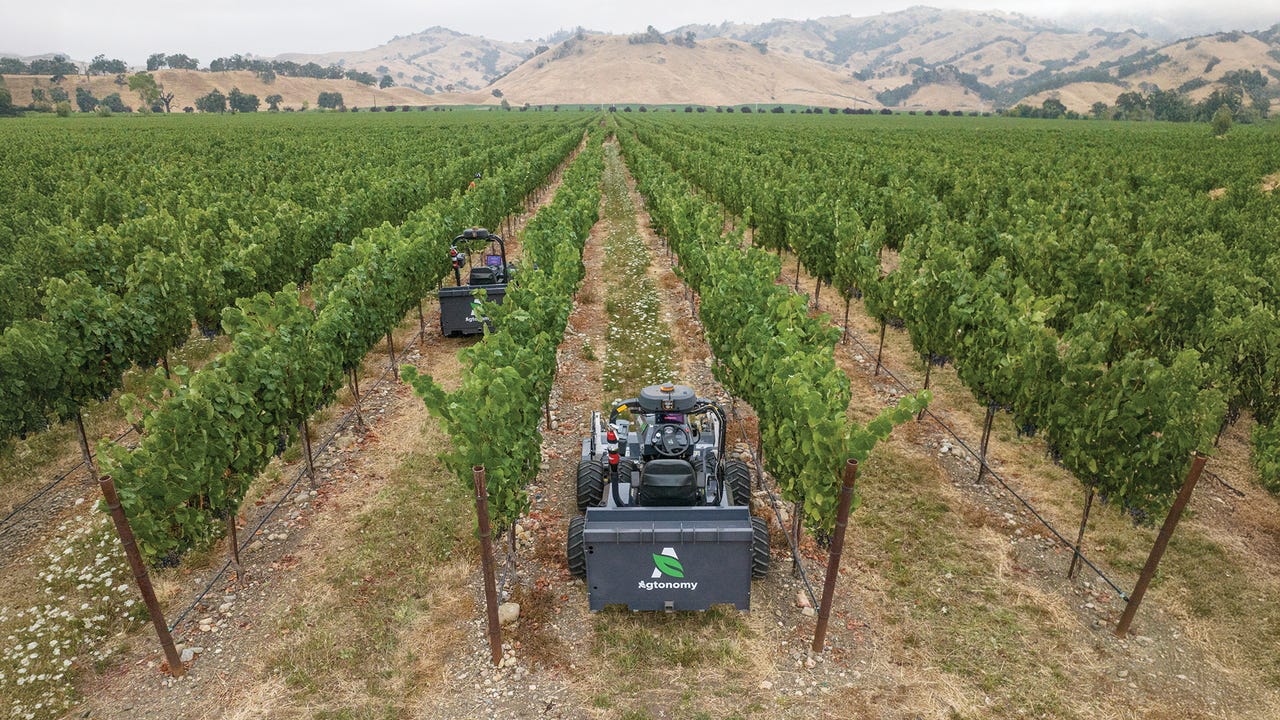The world hit a milestone in 2023: Earth surpassed 8 billion inhabitants. How will they all be fed? Production costs for agriculture are rising, available farmland is shrinking, planting windows are narrower due to volatile weather, and human labor is drying up.
Many machinery brands look to robots and autonomy as an answer to both world hunger and farm profits — if farmers see the return on that investment, that is. If they can, farm machines for specialty and row crops will become robots — and in the not-too-distant future.
“One of the major drivers for autonomy is labor savings — it’s the dull, dangerous, dirty work” that’s difficult to fill, says Chris Whitney, chief digital officer at Monarch Tractor, which makes electric robotic tractors for specialty crops. “If you have an autonomous tractor, the labor part of it goes away.”
Savings are compounded with more autonomous machines because one person can oversee work that once took several skilled operators.
“That’s where the ROI for the grower really, really shines — when you’re paying $70,000 a year for skilled labor, but you can’t hire enough workers because they’re not available,” says Tim Bucher, founder of Agtonomy, a California company.

Iowa farmer Michael Stenzel also understands this from experience. He takes all the help he can get.
“The problem we’re having is putting someone in the seat,” he says.
So when John Deere approached him about four years ago to bring autonomous equipment to his farm, Stenzel says he jumped at the chance: “I said, ‘I want the biggest tractor you have, and I want a ripper’ because that’s the slowest process of my farming operation.”
These days, autonomous tillage is an integral part of Stenzel’s farm.
Bringing it all together
The technology that’s driving farm machine automation has been a long time coming. Over decades, engineers have been developing advancements — from autosteer in the 1990s to precision planting, centimeter-level guidance, advanced connectivity and telematics more recently. Now, these distinct processes are coalescing into autonomy.
“Everything in the ecosystem needs to be brought together to orchestrate an operation,” Whitney says. And those connections are made by another recent advancement: artificial intelligence.
While some brands like Monarch Tractor build automated tractors, others such as Sabanto in Iowa make retrofit kits that connect the disparate systems on existing machines via a hub computer system.
“We believe the next-generation tractor is already sitting in your machine shed,” says Craig Rupp, CEO of Sabanto, which launched a fully autonomous retrofit kit in 2023. The kit ties into the telematics of newer John Deere, Fendt and Kubota tractors.
“We install an obstacle detection system — 12 cameras in addition to a time of flight, infrared sensor and a radar sensor. We monitor all aspects of the tractor and the implement as we’re going through the field,” Rupp says.
“We picked the tractor platform because it’s the Swiss Army knife of agriculture,” Rupp says. “It’s a very capable platform. We’re doing extremely high-frequency field operations every day.”
Autonomous evolution
From startups to behemoths, large and small machinery brands are universally moving toward total autonomy. As the tech gains a foothold, the competition is heating up.
“In some ways, we’re in a bit of an arms race,” says Eric Hansotia, CEO of Agco.
Earlier this year, Agco’s PTx Trimble launched a retrofittable tractor kit called OutRun, which can automate grain cart operations. Soon after, CNH Industrial’s New Holland announced a partnership with Israeli robotics company Bluewhite to automate its specialty tractors. And most recently, John Deere launched a retrofittable camera kit for its 2020-and-newer 8R and 9R tractors that can automate tillage.
“You shouldn’t just be able to enjoy this technology if you buy a new machine from John Deere and it gets delivered out of the factory,” says Jahmy Hindman, chief technology officer at John Deere. “You should also be able to enjoy this technology if you own an older tractor … by installing this kit.”
With farmers starting to invest in the technology, autonomy might follow the path of autosteer. “If you think about how guidance grew, it didn’t happen through OEMs,” Hansotia says. “We think autonomy will be the same. This is going to be something farmers step their way into. As we do that more and more, we can pull the driver out.”
Solving labor shortage
Autonomy stands to overhaul the way farming is done by letting farmers do more with less.
“When we think of the continuation of the American farm, automation is key,” Dinen Subramaniam, with Agco’s JCA Technologies, says.
To that end, Subramaniam says PTx Trimble’s brand-agnostic approach to retrofitting existing machines “decouples the purchase of a new tractor from autonomy,” giving farmers of all sizes a chance to upgrade their equipment.
And change is happening — fast.
Hindman estimates 2.4 million U.S. farm jobs need to be filled yearly. Meanwhile, the average age of U.S. farmers is 58. Continued rural-urban migration will further reduce the labor force, which begs the question: What will farmers do when they can’t hire labor at all?
Regardless of color and competition, farm machinery brands agree on the answer.
“There’s a common thread that connects all of this together: labor shortage,” Hindman says. “We think autonomy is a significant answer to that question. It’s a solution to that dilemma.”